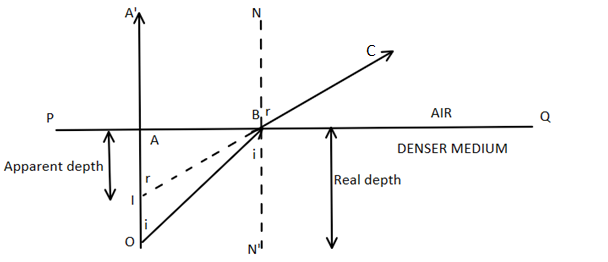Question
Question: How is the refractive index of a material related to real and apparent depth ?...
How is the refractive index of a material related to real and apparent depth ?
Solution
Consider a material and a ray of light falling on its surface at some angle θ. The ray of light will refract. Relate the angles made by line of sight and the refracted ray and represent it in terms of refractive index μ.
Complete step by step answer: First we will understand in brief the meaning of real and apparent depth and then proceed to our derivation of relation between them in terms of refractive index.
An object placed in a denser medium when viewed from a rarer medium appears to be at a depth less than the real depth. This depth is the apparent depth and this happens due to refraction of light.

Now we will proceed towards our derivation.
Consider a point object O kept at the bottom of a transparent medium. Let PQ be the surface that separates the medium and air.
Now we will consider two rays emerging out from our point object O.
First of all we will consider ray OA which is incident on surface PQ normally such that it passes undeviated. The second ray that we will consider is ray OB which strikes the boundary surface PQ at Band suffers refraction.
We should keep in mind the fact that when a ray travels from denser to rarer medium, it bends away from the normal and so does our ray OB.
When viewed by the eye, the ray BC appears to be coming from point I. This point actually represents the virtual image of the object O. So our object O will always appear to us at less depth that is AI in this case and not the actual depth AO. Now we will represent the whole phenomenon mathematically.
For incident ray OB, the angle of incidence i=∠OBN′ and r=∠CBN
Since, AO and BN′ are parallel, and OB is the transversal line, we can say that
∠AOB=∠OBN′=i
Similarly,
IA′and BN are parallel and IC is the transversal line, so
∠BIA′=∠CBN=r
Now we will use some basic trigonometric relations.
In right angled △BAO,
sini=OBBA
In right angled △IAB
sinr=IBBA
We need to now recall the Snell’s law which says that the refractive index of air with respect to a medium mμa=sinrsini
Substituting the above values
μ=IBBAOBBA=OBIB
Refractive index of medium with respect to air
aμm=mμa1=IBOB
Since the point B is very close to point A in reality, we can approximate IB=IA,OB=OA
Hence, aμm=IAOA=Real depth÷Apparent depth.
Note: You should have a firm grip on basic concepts of trigonometry and should be familiar with the phenomenon of refraction, reflection, etc. and should be well versed with the laws associated with them.
